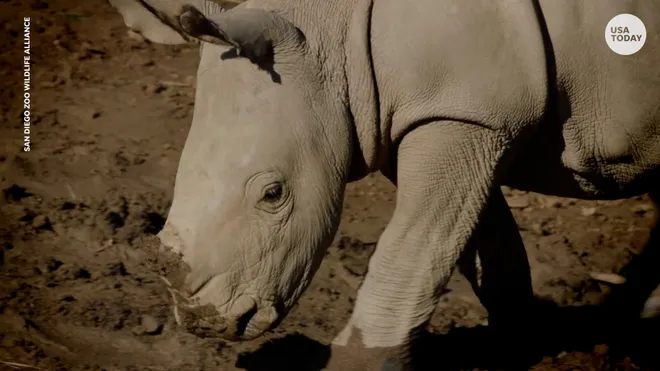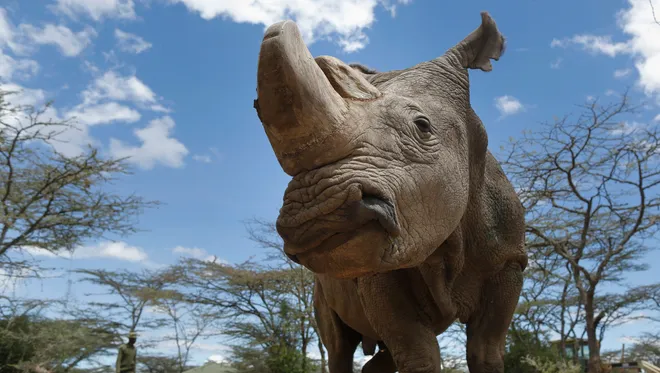First IVF rhino pregnancy could save northern white rhinos from the brink of extinction.
There are two known Northern white rhinoceroses left in the world, but scientists say a breakthrough with invitro fertilization - and a surrogate Southern white rhinoceros - could create a path to save the critically endangered Northern white rhino from complete extinction.
BioRescue, an international group of scientists in Germany, and the Leibniz Institute for Zoo and Wildlife Research announced that a test embryo was successfully implanted into a southern white rhino named Curra.
"As most rhino species and subspecies face impairment of natural reproduction and are threatened with extinction, new approaches to their conservation are required," writes BioRescue in a statement from October.
Curra died two months into her 16-month pregnancy from an unrelated bacterial infection, but the successful implantation of the egg shows promise in advanced assisted reproduction technologies.
Jan Stejskal from BioRescue told National Geographic the advancement gives them “proof of concept” that this technique will help other rhinos.
The breakthrough could create a path to save the critically endangered northern white rhinos from complete extinction. Two infertile females are being kept in Kenya and are the last known members of the species.
National Geographic reports it exclusively documented the process of using IVF on the rhino for an upcoming series, "Explorer". It is set to premiere on Disney+ and Nat Geo in 2025.
More stories about Rhinos:Rising temperatures from climate change could threaten rhinos in Africa, researchers say.
Why it's important
Najin and her daughter Fatu are the last known northern white rhinos. The female rhinos are infertile and currently live under constant surveillance at the Ol Pejeta Conservancy in Kenya, said the Leibniz Institute in a statement.
According to the New York Times, the two northern white rhinos, a subspecies of the white rhinoceros, are living in a state of "functional extinction." This is because the subspecies was no longer viable since two females can not save the species.
But stored away in Italy and Germany are the living cells of 12 different northern white rhinos.

According to BioRescue, advanced assisted reproduction technologies are the only way to create northern white rhino offsprings.
The group says it plans on using IVF to implant a northern white rhino embryo into a southern white rhino mother.
"The two subspecies are similar enough, according to the researchers, that the embryo will be likely to develop," writes National Geographic.
Researchers had to overcome more than several obstacles to get to this point.
"The embryo transfer in this subspecies is entirely new ground as a veterinary and scientific procedure, and all protocols, methods and pieces of equipment had to be newly developed from scratch," the Leibniz Institute for Zoo and Wildlife Research said in a press release.
How did they successfully use IVF on Curra?
While Curra's pregnancy did not go full term because of her premature death, it still proved that the method developed by BioRescue researchers made it possible to impregnate a southern white rhino using IVF.
This treatment has been well-established for humans. People can even purchase at-home artificial insemination kits, reports USA Today.
However, it's completely uncharted territory when it comes to a massive animal like a rhino, said Thomas Hildebrandt, the head of the BioRescue project, in a statement.
"Together with the team and many professional partners, I developed the devices that can actually find and access the required location [to] insert the tiny embryo into a 2-ton animal," Hildebrandt said. "It took many years to get it right, and we are overwhelmed that we now have proof that this technique works perfectly."
According to a statement from the Leibniz Institute, here is the series of events:
- Researchers used sperm from Athos, a southern white rhinoceros from Zoo Salzburg in Hellbrunn, Austria, to fertilize oocytes, a developing egg, from Elenore, a southern white rhinoceros living in the Pairi Daiza Zoo in Belgium. The oocytes were fertilized using in vitro.
- Embryos were transferred to the Ol Pejeta Conservancy in Kenya.
- Curra was placed in a pen with Ouwan, a vasectomised and sterile teaser bull who attempted to mate with Curra on September 17 and 18, signaling to researchers that it was the best time to transfer the embryos.
- BioRescue scientists and vets transferred two embryos into Curra. Two were used to increase the chances of a successful implantation.
- Curra was placed back in the pen with Ouwan. He was no longer interested in mating her which was the first sign the transfer was successful.
- Researchers planned on performing a pregnancy check on Curra on November 28.
- Heavy rains flooded the surrogate enclosure and set free dormant clostridian bacteria spores.
- Ouwan was found dead in the pen six days before the exam.
- Curra was found dead in the pen three days before her exam.
- Dissection revealed an extreme bacterial infection caused by the flooding and dormant bacteria. They also discovered that Curra was pregnant with a 70-days-old male fetus.
- Researchers collected samples of the fetus and sent them to Max Delbrück Centre for Molecular Medicine and the Leibniz-IZW in Berlin, Germany.
- In January, a DNA analysis confirmed the fetus was the result of the embryo transfer.
What's next?
According to the zoo, researchers are working on picking a new teaser bull and surrogate mother.
This will take a few months. Once that is done, they will transfer a Northern White Rhino embryo.

Disclaimer: The copyright of this article belongs to the original author. Reposting this article is solely for the purpose of information dissemination and does not constitute any investment advice. If there is any infringement, please contact us immediately. We will make corrections or deletions as necessary. Thank you.





